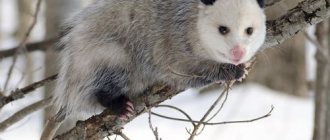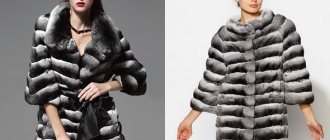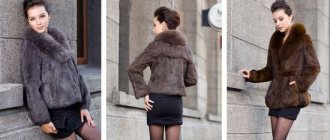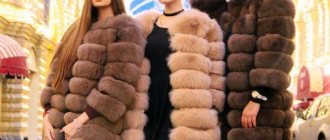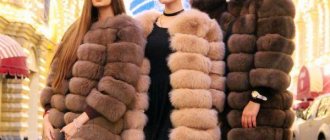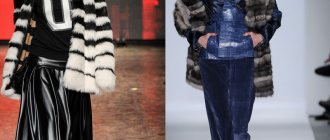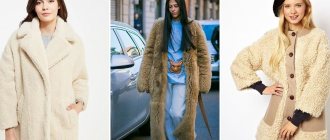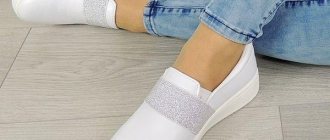Raccoon fur
The animal is similar in size to a fox, but with a shorter, bushier tail; It also looks a little like a jackal, but the fur is thicker, taller, and softer. There is mane on the neck; the fur cover is very high (up to 11 cm), thick, rough, brown on the head, with gray-bluish down. On the back, the spine is tricolored: brown bottom, gray-yellow middle with black ends, sometimes with yellowness. Summer specimens have a prominent black cross on their back.
One long molt from mid-spring to mid-autumn begins with the gradual emergence of first the down, then the awn. By mid-summer, a coarse, sparse awn remains. In autumn, low awns first begin to appear. By mid-autumn it grows back, and at the same time new thick fluff grows.
Considering that too high fur of a raccoon dog degrades the value of the skin, making it less similar to the more valuable striped raccoon, it is more advisable to hunt mainly in late autumn rather than winter, which makes it possible to obtain skins with lower and, therefore, valuable fur, more similar for gargle.
Raccoon dog furs are used for coats and ladies' collars. Raccoon fur is used for products in both natural color and dyed (silver-black fox); in addition, it is pinched, cut and dyed black. Once upon a time, skins of the so-called “Japanese fox” were in use - these are nothing more than the skins of a raccoon dog dyed dark blue. Down is delicate, soft and is a valuable raw material for the knitting industry (Orenburg-type scarves).
Due to the great density and height of raccoon fur, the seams on the skins are less visible than on the skins of a fox.
Dog fur coat: what does it look like and what is best to wear with it?
Every representative of the fair sex dreams of a luxurious fur coat that will warm both body and soul during the harsh winter months. But then not everyone can afford it. After all, elite furs such as arctic fox, mink and sable cost quite impressive sums. There are also cheaper furs, for example, astrakhan fur and fox. But again, not every woman can pay fifty or one hundred thousand for a fur product. Therefore, designers and fashion designers make budget models of dog fur coats. Yes, yes, that's not a typo. Even in our modern world you can still find good and beautiful dog fur coats.
But believe me, not all breeds are suitable. This does not mean at all that you can become the owner of a fur coat made from some stray dogs. Raccoon dogs are specially bred to make such fur products. Only their fur is suitable for making very attractive and inexpensive fur coats. Raccoon dogs are very similar in appearance to raccoons. They have an elongated muzzle, on which there is a “mask”, like raccoons. But at the same time, they are much larger than raccoons, have short legs and a massive body that ends in a small but fluffy tail. They reproduce well both in the wild and in captivity. Distributed in the European part of Russia and the nearest northern countries of Europe.
Fur color changes depending on the time of year. In summer, raccoon dogs acquire a beautiful reddish color with black longitudinal stripes. In summer they become more silvery. Often in nature you can find completely white albinos. Fur coats are rarely dyed or coloured. On sale you can find fur products only in natural colors.
By appearance, it is quite problematic to distinguish a fur coat made from a raccoon dog from a fur coat made from a raccoon. They look almost equally luxurious and attractive. The main difference is the softness of the fur. A raccoon dog's fur is much coarser; it cannot be called soft and fluffy. Autumn is very tough. But at the same time, such coats are much warmer than raccoon coats and can withstand temperatures of up to thirty degrees. Also, due to the rigidity of the fur, the service life of the fur product increases. If worn carefully, they will last you up to ten to twelve years and will not lose their attractiveness.
And, of course, one of the main advantages of these fur products is the price. Such fur coats can be purchased for 10,000 or more. For such a small amount you can become the owner of a beautiful fur product that will serve you for a long time and at the same time will keep you warm in harsh winters. An excellent alternative to any down jacket or jacket.
This fur is very rarely counterfeited. Because there are plenty of raw materials for making fur coats and the skins are processed very easily. But just in case, ask the seller for a certificate for the fur product you like. It must indicate that the fur coat is made only from raccoon dog fur. And the price for them should be appropriate.
The wardrobe for these fur coats should be selected based on their length. If you have a short fur coat that reaches mid-thigh, then the best combination would be skinny black pants and high boots. In this case, shoes can be made of either genuine leather or leatherette or suede. The main thing is that the shoes match the texture and color of the handbag. Ankle boots and short ankle boots also look good with raccoon coats.
Any bags are suitable. Even those that can be worn on the shoulder or forearm. After all, the fur is so hard and thick that additional loads on it will not harm it in any way. If the fur coat is midi or floor length, then choose an elegant dress or skirts. Boots can be knee-length. There is also no need to worry about the headdress. After all, most often raccoon coats are made with a large and warm hood. Therefore, in cold weather, just throw it on your head, and you will definitely not freeze.
Fur coats
- Valuable tips for choosing a goat fur coat
The fashion for goat fur coats arose at the beginning of the 20th century. By the end of the century, the products won among...
- What to do if your fur coat is stolen?
An expensive and beautiful fur coat is a bait for a thief. If he sells it, he will get a considerable amount for it. How…
- Where can I find a showroom with fur products?
Nowadays, you can increasingly find information that purchasing a high-quality fur product...
- The most popular shopping centers for fur sales in Russia and abroad
If you are seriously thinking about purchasing a beautiful and expensive…
Fashion
- What scarf to wear with a fur coat?
Fur coats are a real decoration for any representative of the fair sex. Therefore, overload your image...
- What to wear with a jungle cat fur coat and how to distinguish it from other fur coats?
The jungle cat is a wild animal that is found in Central Asia,…
- Until what degree of frost can you wear mink coats?
The mink coat is certainly one of the most popular and beautiful models that are very…
- What to wear with an honorik fur coat? Appearance of Honorik's fur
If you dream of an inexpensive and high-quality fur coat that will delight you in…
Care
- What to do with splits in a fur coat?
A mink coat is quite an expensive thing, so every owner tries to properly care for it...
- How to bleach a yellowed fur coat?
Owners of light fur coats often face the problem of changing the color of their favorite product. Yellow…
- How to sew a short fur coat from a fur coat?
The bottom of your favorite fur coat is damaged? Or are you just tired of the style? Make a beautiful sheepskin coat out of a fur coat! How…
- The fur coat crunches and rustles: what to do?
In the process of wearing fur products, defects often arise. For example, the owner of a mink coat can...
Removing and dressing a raccoon skin
Video 18+
The primary processing of raccoon skin is similar to that of fox skin, but the width to length ratio should be 1:4. Raccoon dog skins are removed with a tube, cutting along the rump; When removed, the fur on the head, paws and tail is preserved. Degrease without damaging the root system of the hair and clean from traces of blood, remaining meat tissue and tendons; bones from the tail and limbs, cartilage from the ears are completely removed. The skins are straightened with the fur facing out according to the rules. Preservation is carried out using the fresh-dry method.
Uncut skins are dressed mostly with a tube, but can also be cut flat, and are straightened symmetrically; the head, limbs and tail are preserved during the dressing process. The shorn ones are trimmed flat and straightened out well. The head, limbs and tail are removed during the dressing process.
The area of the skin is calculated by multiplying the length, which is measured from the center between the eyes to the beginning of the tail, and the width in the middle of the skin. For skins that were tanned using a tube, the resulting width is multiplied by 2. The result of the calculations must be rounded to the nearest dm2.
Raw raccoon skins
Raccoon dog skins are not divided into ridges. There are 3 varieties:
- Winter, full-haired, slightly blue underbelly is allowed.
- Late autumn, less full-haired, with bluish flesh.
- Autumn, half-haired, with sparse down and blue flesh.
Late winter ones, with thinning fur on the back of the neck and sides, are classified as medium and large defects. Spring, summer, early autumn and young skins are classified as non-varietal and are valued by agreement, but not more than 25% of the cost of 1 grade.
Defects in the fur of a raccoon dog include holes, tears, poor degreasing, bald spots, chafing on the neck and drafts, which are specific to this animal. Since the fur on the skin is very long and thick, during dressing they are easily subject to tangling, which has to be combed out.
Quality control
Raccoon dog skins
After the successful acclimatization of this animal, it became a common commercial species in many regions of our country. It is also bred in fur farms.
Description of fur. Differences from related species
The size of a raccoon dog's skin is almost the same as that of a fox. The length is 65 - 80 cm, the tail is 15-25 cm. The fur is tall, thick, brown in color with a gray or yellowish tint. The guard hair is long and coarse, on the ridge it is three-colored: the top is dark brown, the base is brown, and between them there is a light ring of yellow or gray-yellow color. On the cheeks, long covering hairs form so-called “sideburns”, and on the neck there is a mane. Black cheeks are bordered by blond hair. The down is tall, soft, dark gray or gray in color, sometimes with a blue tint.
The tail is short, bushy, the color is the same as on the ridge. The womb, arch and paws are brown.
1
In general, in appearance, the fur of this animal is similar to that of the jackal, fox and raccoon, but has a number of characteristic distinctive features.
Differences from the jackal: smaller size, taller, fluffy and soft fur, shorter and more fluffy tail, presence of sideburns, dark belly and paws.
Differences from the fox: tall lush hair, darker color, brown paws and belly, short and bushy tail - there is no white color at its tip, dark sideburns.
Differences from the striped raccoon: it is larger in size, the hair is higher and more luxuriant, it does not have a pattern of transverse dark stripes, the tail is shorter and more luxuriant.
Geographical variability of the raccoon dog is present, but currently there is little information on it, so there is no division into ridges
Specimens obtained in different regions of the country have differences in shades of fur color and its softness.
The raccoon dog is one of the animals that go into hibernation, so during the year it has one long moult, which begins in early spring.
The fur becomes dull and rough, then gradually thins out. Old guard hairs persist until summer; only in July do they begin to gradually fall out, replaced by new growth. At the end of summer and beginning of autumn, the skin completely gets rid of old hair and is covered with new ones. During this period, the fur consists of a low, young spine; the fluff begins to grow only with the arrival of autumn. Closer to winter, the hair reaches full development.
Characteristics and evaluation of fur at different times of the year
First grade (winter). The skin has a fully formed cover, consisting of a high, shiny, rough spine and thick down. The tail is bushy. The flesh is thin, light or slightly blue.
First grade, third group of defects (late winter). The fur is thick, tall, lush and slightly dull. The fluff begins to feel felt in places. The tail is bushy. The skin tissue is thickened in the area of the shoulder blades and neck, there is no blue discoloration.
First grade, fourth group of defects (early spring). The hair is tall and dull, with thinning hair and felted down on the sides, rump and neck. The tail is still bushy and dull. The mesra is thickened, but without blueness.
Non-standard (spring, summer, early autumn). Spring skins have dull fur, with patches of fluff falling out in places. The spine and leather tissue are rough. In summer, the hairline consists of overripe, coarse guard hairs; there is practically no fluff. The tail is thin. At the beginning of autumn, the old awn falls out and at the same time the growth of short shiny awns occurs. Young fluff is just beginning to appear. The tail is thin, the flesh is dark.
Third grade (autumn). The fur is thick and shiny, but only half grown. It consists of a dense, shiny awn, slightly protruding above the down, and thick, silky, but low down. The tail is not bushy enough. The skin tissue is thick and blue.
Second grade (late autumn). Skins with thick, shiny hair, slightly inferior in height to winter fur. The tail is bushy. The flesh is thickened, slightly blue over the entire area.
Primary processing rules
According to the rules, skins must be removed with a tube. At the same time, the paws, tail, head with nose and ears are preserved. Degreasing should be approached more carefully: all cuts of meat and tendons are cleared, bones from the paws, tail, and ear cartilage are removed. Editing is done with the fur facing out. The rules are used sliding No. 1 or forked No. 2.
For raccoon dog and raccoon
Fresh-dry canning.
Fur defects and their cost
Such fur, obtained by hunters, often has various defects: drafts, bald spots, holes. They are formed due to improper fleshing, poor degreasing, and inept editing. The specific nature of hunting an animal with dogs and a gun leads to the formation of dog bite marks and shot holes on the skin.
The cost of skins varies over the years from 800 to 1200 rubles. The greatest influence on price formation is exerted by the need of the fur market for this type of wild fur. Beautiful fur coats, chic collars and hats are made from natural and tinted fur.
